What are Orthotics and Functional aids?
Orthotics and Functional aids can take many forms:

Functional Orthotics: to support irregular foot biomechanics (such as pronation and drop foot)
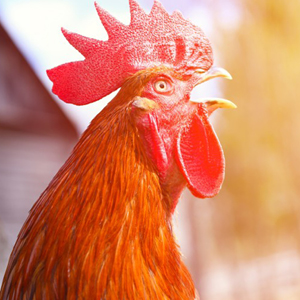
Accommodative orthotics: to relieve minor foot irregularities and painfulness (such as gait plates, braces and splints)

Mobility Aids: ranging from canes and walking sticks, walking frames, mobility or wheelchairs, functional clothing to buggies and scooters.

Functional Aids including: aids for daily living – alternative and augmentative communication – seating and positioning equipment – computer access aids – environmental controls – home modifications – sensory aids- recreation devices.
Orthotics and Functional aids
Orthoses in polio management are used to assist with control of movement, correct or prevent joint deformity, compensate for muscle weakness, and improve energy efficiency. A comprehensive biomechanical assessment is required to assess gait, lower limb strengths/weaknesses, joint mobility and the compensation strategies employed for movement. Orthoses are subsequently prescribed based upon this assessment.
Lower Limb
- Foot Orthoses (or insoles): improve foot alignment, effect the alignment of the joints above, and often used to redistribute pressure and provide comfort.
- Ankle-Foot Orthoses (AFO): assist in control and stability of the ankle-foot region; have a role in influencing knee biomechanics, and substitute for weak ankle muscles including the calf muscle.
- Knee–Ankle–Foot Orthoses (KAFO): support the whole lower limb, substitute for weak quadriceps and compensate for severe muscle weakness and knee malalignment.
- Walking aids may be required in addition to orthoses, particularly in the case of weak hip muscles.
Spinal And Abdominal
- Rigid braces support kyphosis or scoliosis.
- Abdominal binders or corsets support weak abdominals and diaphragm, andassist with breathing, coughing, and back pain.
Mobility aids ranging from canes, walking sticks, crutches and walking frames can be life savers by allowing people to function and keep them safe in the process. Prolonged use of mobility aids can unduly stress shoulders if not managed carefully.
Functional aids can be found to be useful in many tasks we can be finding more difficult such as opening things, taking care of ourselves, sitting down and getting up, keeping in touch with people and having fun. These devices can change our lives.
Common symptoms of requiring Orthotics and Functional aids:
The ankle is out of alighnment
Tripping and falling
Foot pain while standing or walking
Muscle tightness and/or recurrent muscle tears and strains
Pain in the knee, hip, back or nek
Calluses, corns and bunions
Shoes wear out unevenly or unusually quickly
Difficulty with tasks requiring strength of grip or lifting and bending
Changes in the need for Orthotics and Functional aids
If the signs are becoming obvious that you need to get new or better othotics or some sort of functional aid, you will need an assessment and referral to to access these things from the public health system, either from your GP or through the Duncan Foundation. As the public health system is not always an easy system to navigate through and negotiate with, it is always helpful to have good and well communicated information, as LEoP issues are often not well understood by health professionals.
If you have the resources, going to private providers will give you more options so that getting a private assessment and quote might be worthwhile.
Things to think about when getting orthotics and functional aides.

What can I do to get better Orthotics and Functional aids?
Don’t wait for things to get worse before acting – this just causes more long lasting damage.
Spend time assessing how well things fit and the usefulness of the aid, as they have to be right for the long haul. Ask for changes if needed.
Get things fixed before they wear out.
Be open to improving range of movement with gentle stretching over the long term. Allow 3 months to achieve significant improvements. Get professional advice if you do this.
Social effects of changing needs for Orthotics and Functional aids
Any change in our bodies capacity and capability is especially significant for people living with the late effects of polio. We have spent a lifetime learning to come to terms with the way people treat us and we have adapted our behavior and personality to suit.
Using new orthotics or functional aids on an everyday basis will change our appearance and become part of our identity. It may also change our energy level, our mobility and access to new places and the enjoyment we get out of life.
The hardest thing about using a cane may be its effect on our shoulder or that we can’t bear to be seen in public using a cane or even worse, a wheelchair, making it harder to “pass for normal“. This is not a trivial thing we can somehow make disappear through will power or giving instructions to our feelings to be quiet.
Everyone has a sense of belonging, something learnt as a child and developed over a lifetime. Thinking that people will see us and treat us differently depending on how we look and move is based on a lifetime of experience, as are our feelings.
If we can accept that most people these days do accept us in a adult way, the gains from looking different will out weigh the negatives and any anxiety can subside. For those that don’t accept us, that really is their problem; you can be sorry for them and try not to take it personally.
Footwear
Residual weakness, tight or lax musculature and foot size difference can lead to problems such as comfort, deformation, energy expenditure, balance and safety.
Footwear is one aspect of management of foot issues. Should orthoses be worn, footwear may be required in a half size larger to accommodate.
Podiatrists, orthotists, specialist footwear suppliers and other practitioners may recommend:
- Extra cushioning to keep the foot comfortable and take weight when the foot has tight muscles and joints and is very rigid (resists movement).
- Built up sections (internally or externally) to compensate for leg length discrepancy.
- Shock absorbing materials in the sole of the shoe if the problem is profound, and also involves the ankle.
- Reinforcing the shoe for extra support and stability to counteract foot flexibility due to weakness.
- Extra depth footwear and moulded uppers to manage hammer, claw or mallet toes or atypical foot shapes to avoid excess pressure or rubbing over the involved joints.
- Extra stability can be gained from shoes that have a broad, flat sole with a nonslip tread.
- Maintenance of uneven wear, e.g. the outer border of the heel, or if the nonslip tread is wearing thin.
Walking Sticks
Walking sticks are most useful for people with mild or moderately reduced balance or who require a walking aid to assist their confidence in more challenging environments.
They are usually held in the hand on the side of the stronger leg and used with every step made by the weaker leg. Weakness or pathology of the upper limbs may limit which hand the device can be held in.
It is worth trying different types of sticks to address different concerns:
- Wooden: easily available and relatively inexpensive.
- Metal: more light weight and often adjustable.
- Folding: good for clients who travel and plan infrequent use of an aid.
- Walking sticks with a seat: useful for walking short distances and if needing o rest frequently. Weight can be an issue.
Walking stick handles also vary:
- Crook handles: less comfortable to lean heavily on, but can be placed over the arm when not being used.
- Right angled / T-shaped handles: generally more comfortable to lean heavily on.
- Swan necked handles: allow body weight to be positioned over the central shaft of the stick and should be considered for someone who relies very heavily on their stick.
- Contoured / arthritis or Fischer handles: are produced to fit a left or right hand and aid even weight distribution for painful hands – most commonly due to arthritis.
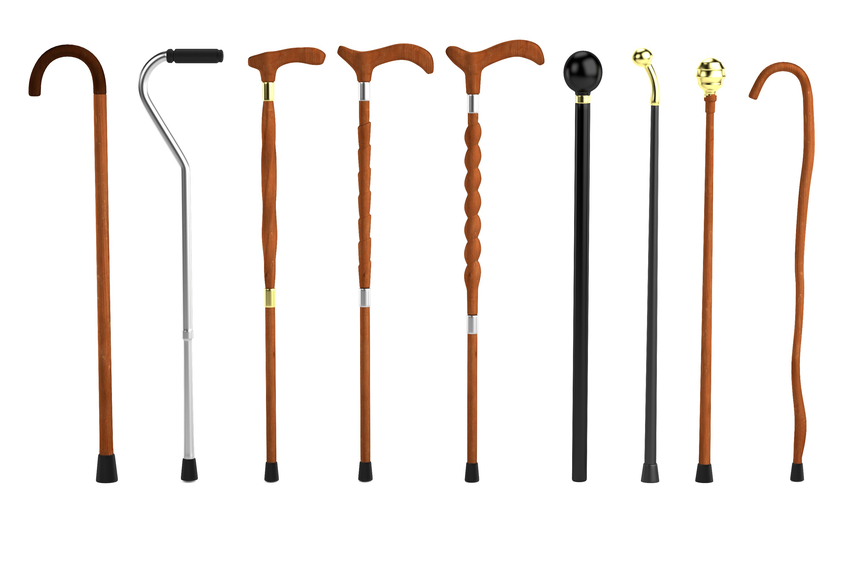
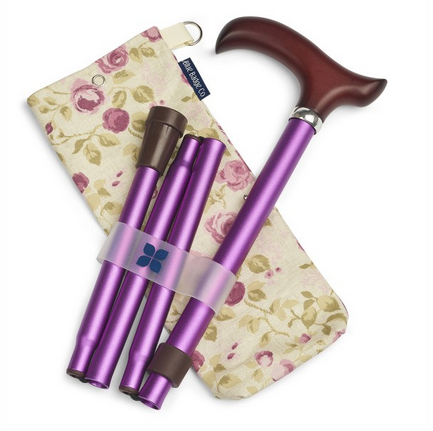
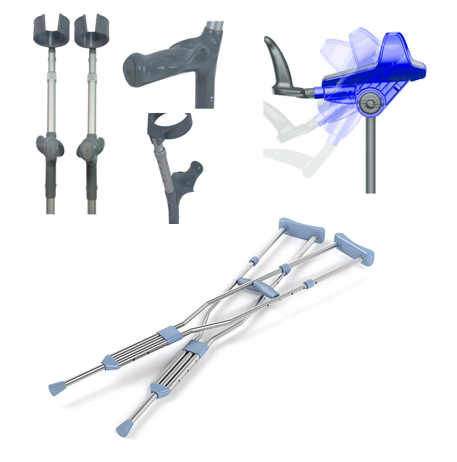
Crutches
Crutches are for people with more significant limb weakness, biomechanical abnormality or loss of balance. They are generally used in pairs and may require a period of gait training by a physiotherapist to achieve the most normal and energy efficient pattern: this can be a two, three or four point pattern with a step to, or swing through, cycle.
Elbow crutches: most commonly metal and adjustable, but can be customised if required. They provide more stable upper limb support than a walking stick due to the hand grip to elbow section which enables the patient to brace their forearm during the stance phase of gait. The elbow cuff also allows the user to retain the crutch if they let go of the handle, e.g. when opening a door. Handles can be standard, contoured / arthritis or Fischer handles, or a gutter arm rest for those with hand paralysis or inability to weight bear on the hand due to pain.
Axillary crutches: provide the most weight relief on lower limbs. Usually only used for clients with extreme weakness of the lower limbs, who are cardiovascularly fit, and have good upper body strength. While they don’t provide an aesthetically pleasing gait, they enable a person with profound leg weakness to tackle flights of stairs and cover distance rapidly. Axillary crutch users must be taught not to lean on the axillary pad as this may interrupt blood flow and nerve supply to the upper limb. Clients using these crutches should also have an alternative means to ambulate as long term / heavy use is challenging for the upper limbs.
Smart crutches: By distributing your body weight over your forearm, it releases pressure and pain from your hands, wrists and shoulders. Fully adjustable, it can be used comfortably as both a platform or forearm crutch.
4 tips for using crutches the right way here
Wheelie Frames
Walking frames are generally considered for people with significant lower limb weakness and/or poor balance. The walking frame has a bigger base of support than a walking stick or crutch so provides inherent stability and enables the patient to off-load more of their body weight. There are many different types of frames, of which the most common ones are outlined as follows.
Pick-up frames: Standard pick-up frames are usually light weight and made from metal. They will have four rubber stoppers / ferrules at the end of their legs for slip prevention. They have foam or moulded plastic hand pieces and can either be adjustable in height, or purchased at a specified size. By design, pick-up frames only allow walking in a three point, restricted pattern and single steps to be taken safely. For this frame to be functional, prospective users need to have the upper limb strength and endurance to lift the frame for every step they take. If they tire quickly, they may benefit from using a wheelie frame instead.
Folding frames: These are useful for people with limited storage space at home or who want to be easily able to transport their frame in the boot of a car. They are inherently less sturdy than a standard pick-up frame.
Two Wheelie: has two wheels at the front and casters, skis or rubber stoppers at the back. Ideal for those who require the stability of a frame but don’t have the upper limb strength for a pick-up frame. These are most appropriate for slow and frail people who only walk inside. An attractive feature of these frames is that they allow walking with a reciprocal gait pattern.
Three Wheelie: has one wheel at the front and two wheels at the rear. The front wheel is multi directional to aid steering. They are easy to fold and fit into a car boot. Ideal for peolpe with reduced balance and confidence and can be used indoors or outdoors. They allow walking with a reciprocal pattern, but provide less stability and customisation options than a four wheelie frame.
Four Wheelie: has two large multi directional wheels at the front and two large unidirectional wheels at the back. It has various braking mechanisms and accessories. A good indoor and outdoor frame which can be used by low-level walkers requiring maximal support and stability, and high-level walkers who want a sturdy frame that will keep up with their pace.
Gutter Frame walkers: are a sturdy wheeled walking frame designed for mobility training and rehabilitation with gutter frames to support the arms.
Brakes
Pressure brakes: works when a person bears weight through his/her arms down onto the frame. This causes the brakes to be applied to the rear wheels and prevents the frame from moving whilst leaned upon. This mechanism works well for some people, but can be a challenge for those who are not heavy enough to activate the brakes, or who lean too heavily on the mechanism throughout the gait cycle.
Hand brakes: appear similar to bicycle hand brakes and are on both sides of the frame. They are operated by squeezing the hand piece, but those with weak or painful hands find them a challenge.
Hand locks: a brake lever that is applied to immobilise the frame. This is an important feature for frames with a built-in seat.
Seats
Built-in seats are useful for people with limited endurance. They remove the anxiety of being unable to find a chair if tiring suddenly. Some agility is required to engage the brakes and then turn around to sit down. When choosing a seated frame check the weight capacity is adequate. The seat height should allow you to easily rise from sitting to standing. Use the brakes at all times when sitting, or else!
Other Accessories
- Trays
- Shopping baskets
- Net / vinyl bags
- Walking stick holders
- Oxygen bottle holders
- Sheep skin seat covers
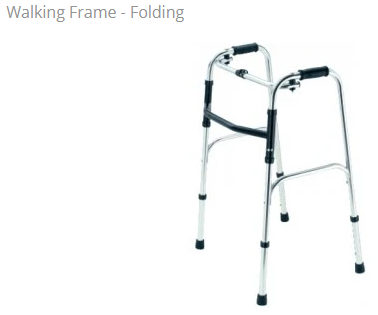
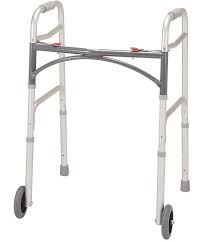
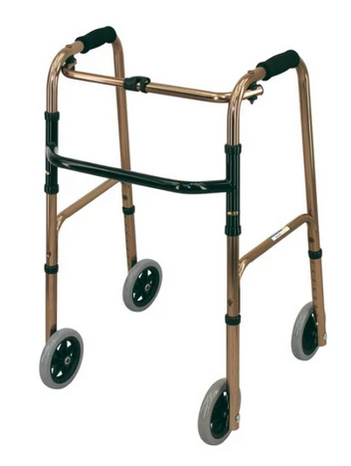
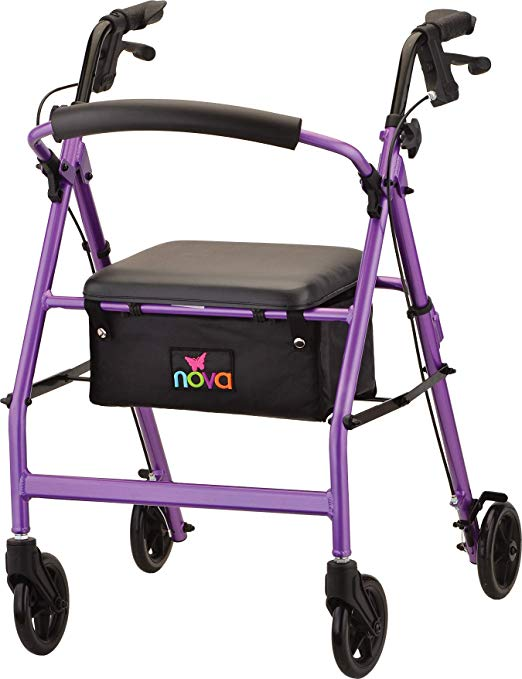
Functional Aids
Many of us living with the late effects of polio could use functional aids to enable us to walk, transfer, carry out daily tasks and personal care. Aids other than the mobility devices shown above extended the physical capacity and capabilities of our upper body that can be restricted by limited range of movement and grip and endurance.
Functional aid are widely used by people living with many different conditions and so are widely available through specialist outlets. Some of the common items include easi-grip kitchen knifes, a car transfer aid, a folding travel grabber stick and much more. Click the links below to explore
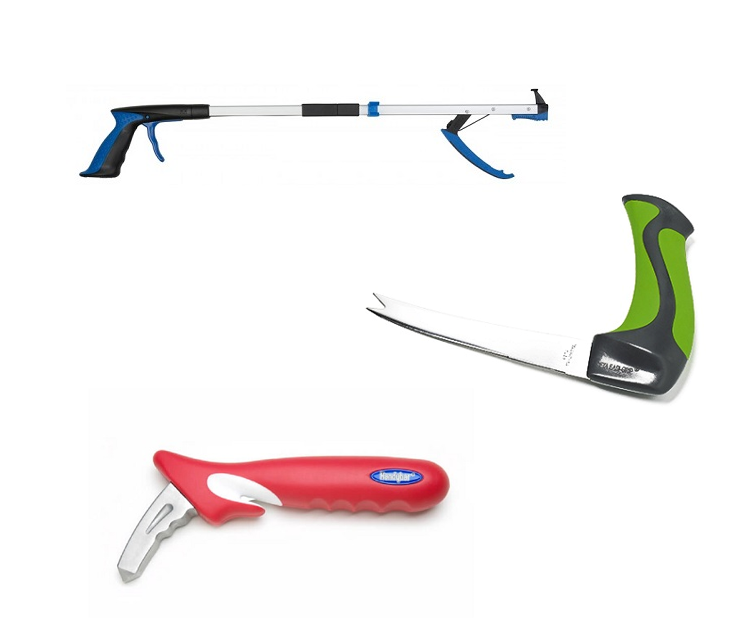
Find out more
Resources, Links and Research Downloads
MoH Orthotic Services Guidlines
Q: Community Health, Transitional and Support Services – Orthotic Services, Tier Level 2, Service Specification.
W: This service specification describes the provision of Orthotic Services and orthoses to eligible1 people of any age, in community and /or outpatient settings, by practitioners who have appropriate qualifications and experience to meet the assessed Orthotic needs of the Service Users within the timeframes set.
A: Well worth knowing when dealing with Orthotics and Allied Health services.
